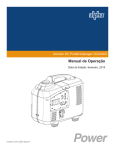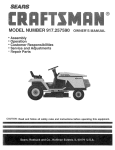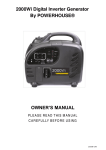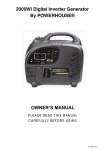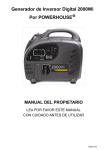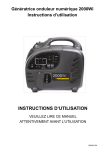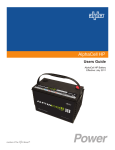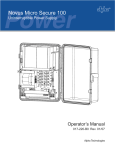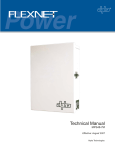Download AlphaGen ACX2000i Specifications
Transcript
AlphaGen ACX2000i 120V Portable Generator Operation Manual Effective: July 2013 Safety Notes Review the drawings and illustrations contained in this manual before proceeding. If there are any questions regarding the safe installation or operation of the system, contact Alpha Technologies or the nearest Alpha representative. Save this document for future reference. To reduce the risk of injury or death and to ensure the continued safe operation of this product, the following symbols have been placed throughout this manual. Where these symbols appear, use extra care and attention. WARNING! ELECTRICAL HAZARD ELECTRICAL HAZARD WARNING provides electrical safety information to PREVENT INJURY OR DEATH to the technician or user. WARNING! FUMES HAZARD FUMES HAZARD WARNING provides fumes safety information to PREVENT INJURY OR DEATH to the technician or user. WARNING! FIRE HAZARD FIRE HAZARD WARNING provides flammability safety information to PREVENT INJURY OR DEATH to the technician or user. There may be multiple warnings associated with the call out. Example: WARNING! FIRE & ELECTRICAL HAZARD This WARNING provides safety information for both Electrical AND Fire Hazards CAUTION! CAUTION provides safety information intended to PREVENT DAMAGE to material or equipment. NOTE: NOTE provides additional information to help complete a specific task or procedure. ATTENTION: ATTENTION provides specific regulatory/code requirements that may affect the placement of equipment and /or installation procedures. The following sections contain important safety information that must be followed during the installation and maintenance of the equipment and batteries. Read all of the instructions before installing or operating the equipment, and save this manual for future reference. AlphaGen ACX2000i 120V Portable Generator Operation Manual 041-036-B000-001, Rev. A Effective Date: July 2013 Copyright 2013 Alpha Technologies, Inc. NOTE: Alpha denies responsibility for any damage or injury involving its enclosures, power supplies, generators, batteries or other hardware, manufactured by Alpha or members of the Alpha Group, when used for an unintended purpose, installed or operated in an unapproved manner, or improperly maintained. NOTE: Photographs and drawings in this manual are for illustrative purposes only and might not exactly match your installation. NOTE: Review this manual before proceeding. If there are questions regarding the safe installation or operation of this product, please contact Alpha Technologies or your nearest Alpha representative. Contacting Alpha Technologies: www.alpha.com or For general product information and customer service (7 AM to 5 PM, Pacific Time), call 1-800-863-3930 For complete technical support, call 1-800-863-3364 7 AM to 5 PM, Pacific Time or 24/7 emergency support To report errors in this document, send email to:[email protected] 041-036-B000-001, Rev. A (07/2013) 3 Table of Contents ACX2000i Safety Instructions..................................................................................................................................................6 1.0 Introduction........................................................................................................................................................................7 1.1 ACX2000i Generator ..............................................................................................................................................7 1.2 ACX2000i Generator Accessories...........................................................................................................................7 1.3 Control Panel..........................................................................................................................................................8 1.4 Serial Number/Bar Code Identification Location.....................................................................................................8 2.0 Operation...........................................................................................................................................................................9 2.1 Oil Level..................................................................................................................................................................9 2.2 Fuel Level..............................................................................................................................................................10 2.3 Air Cleaner............................................................................................................................................................ 11 2.4 Starting the Engine................................................................................................................................................12 2.5 High Altitude Operation.........................................................................................................................................13 2.6 Operating at Extreme Temperatures.....................................................................................................................13 2.7 Using the Generator..............................................................................................................................................14 2.8 AC Application.......................................................................................................................................................15 2.9 Output and Overload LEDs...................................................................................................................................16 2.10 DC Application.......................................................................................................................................................17 2.11 Low Oil Alarm System...........................................................................................................................................19 2.12 Economy Switch....................................................................................................................................................19 2.13 Stopping the Engine..............................................................................................................................................20 3.0 Maintenance..................................................................................................................................................................21 3.1 Emission Control System......................................................................................................................................21 3.2 Maintenance Schedule..........................................................................................................................................22 3.3 Changing Oil.........................................................................................................................................................23 3.4 Servicing the Air Cleaner.......................................................................................................................................24 3.5 Spark Plug Maintenance.......................................................................................................................................25 3.6 Spark Arrestor Maintenance..................................................................................................................................27 4.0 Transporting And Storage..............................................................................................................................................28 4.1 Transporting the Generator...................................................................................................................................28 4.2 Short Term Storage of the Generator....................................................................................................................28 4.3 Infrequent Use.......................................................................................................................................................28 4.4 Exercising the Generator......................................................................................................................................29 5.0Troubleshooting.............................................................................................................................................................30 5.1 Engine will not start...............................................................................................................................................30 5.2 Equipment does not Operate................................................................................................................................31 5.3 No Output at the DC Receptacle...........................................................................................................................31 6.0 Specifications................................................................................................................................................................32 7.0 Warranty And Consumer Information............................................................................................................................33 Appendix A – Emission Control System Warranty.................................................................................................................35 Appendix B – Emission Control System................................................................................................................................36 Appendix C – Safety And Charging Instructions...................................................................................................................36 4 041-036-B000-001, Rev. A (07/2013) Figures & Tables Figure 1-1, Generator Controls............................................................................................................................. 7 Figure 1-2, Control Panel Component Identification............................................................................................. 8 Figure 1-3, Serial Number Location...................................................................................................................... 8 Figure 1-4, Checking Engine Oil........................................................................................................................... 9 Figure 2-1, Fuel Level......................................................................................................................................... 10 Figure 2-2, Air Filter Components....................................................................................................................... 11 Figure 2-3, Starting the Engine........................................................................................................................... 12 Figure 2-4, Temperature Range and OilTypes.................................................................................................... 13 Figure 2-5, Grounding the Generator.................................................................................................................. 14 Figure 2-6, Control Panel AC Applications Components..................................................................................... 15 Figure 2-7, Overload LED Location..................................................................................................................... 16 Figure 2-8, Battery Charging............................................................................................................................... 17 Figure 2-9, Circuit Breaker Location.................................................................................................................... 18 Figure 2-10, Low Oil Alarm LED Location........................................................................................................... 19 Figure 2-11, Economy Switch Location............................................................................................................... 19 Figure 2-12, Engine Switch Location................................................................................................................... 20 Figure 3-1, Example of Emission Control Tag..................................................................................................... 22 Figure 3-2, Temperature Range and OilTypes.................................................................................................... 23 Figure 3-3, Changing Engine Oil......................................................................................................................... 23 Figure 3-4, Cleaning the Air Filter........................................................................................................................ 24 Figure 3-5, Accessing the Spark Plug................................................................................................................. 25 Figure 3-6, Gapping the Spark Plug.................................................................................................................... 26 Figure 3-7, Maintaining the Spark Arrester.......................................................................................................... 27 Figure 4-1, Cranking Motor to Distribute Oil in Cylinder...................................................................................... 29 Table 3-1, ACX2000i Maintenance Schedule...................................................................................................... 22 Table 6-1, ACX2000i Generator Specifications................................................................................................... 32 041-036-B000-001, Rev. A (07/2013) 5 ACX2000i Safety Instructions Alpha considers customer safety and satisfaction its most important priority. To reduce the risk of injury or death and to ensure continual safe operation of this product, read this manual entirely and follow all safety information therein. WARNING! INJURY HAZARDS • The muffler is hot during and after operation for a few minutes. • Do not to touch the muffler while it is hot. • Keep away from moving parts while the generator is running. WARNING! FUMES & FIRE HAZARD • Generator produces poisonous carbon monoxide. Never run the generator in an enclosed area. • Gasoline is extremely flammable and explosive under certain conditions. • Refuel in a well ventilated area with the engine stopped. • Keep away from cigarette smoke and sparks when refueling the generator. • Wipe up spilled gasoline immediately. • Let the engine cool before storing the generator indoors. WARNING! ELECTRICAL HAZARD Generators are a potential source of electrical shocks when misused; do NOT operate wet conditions. CAUTION! • Do not operate the generator in rain or snow, and do not let it get wet. • Do not modify the enclosure of this generator. • To avoid equipment damage, always check the oil and fuel level and air filter before you start the engine. • Place the generator at least 3 ft (1 m) away from buildings during operation. • Operate the generator on a level surface. If the generator is tilted, fuel spillage may result. • Know how to stop the generator quickly and understand operation of all controls. Never permit anyone to operate the generator without proper instructions. Read the entire manual and review all the drawings and illustrations contained in this manual before proceeding. If there is any question regarding the safe installation or operation of the product or its components, contact Alpha Technologies or the nearest Alpha representative. Save this document for future reference. 6 041-036-B000-001, Rev. A (07/2013) 1.0 Introduction 1.1 ACX2000i Generator Gas Cap Spark Plug Access Cover Control Panel Starter Grip Choke Lever Spark Arrestor Primer Bulb Exhaust Grill Fuel Valve Maintenance Panel Figure 1-1, Generator Controls 1.2 ACX2000i Generator Accessories The following additional items are included with the generator. Keep all accessories in a convenient location for future use or reference. • Battery Charge Kit • Oil Jug • Oil Drain Pipe • Quick Start Guide • Screwdriver • Spare Spark Plug • Spark Plug Wrench 041-036-B000-001, Rev. A (07/2013) 7 1.3 Control Panel 120 V 20A Duplex Receptacle 120 V 20A Circuit Breaker Overload LED (Red) 120V AC 20A NEUTRAL FLOATING NEUTRE FLOTTANT OVERLOAD Circuit Breaker RUN Run LED (Green) Low Oil Alarm (Red) LOW OIL DC 12V 8.3A Ground Terminal ON Economy Switch OFF SYSTEM FLOATING SYSTÈME FLOTTANT Battery Charge Engine Switch Circuit Breaker Battery Charge Receptacle Figure 1-2, Control Panel Component Identification 1.4 Serial Number/Bar Code Identification Location The generator bar code number and the engine serial number identify your particular unit and are necessary when ordering parts and accessories. These two numbers are used by the dealer and The Coast Distribution System, Inc. for warranty administration and must be supplied before any work can be done. The engine serial number can be found stamped on the engine block above oil dipstick. It is visible when the maintenance panel is removed. The bar code number label is found in three locations: • On the side of the generator near the fuel valve. • On the back of this manual. The BCN number is on the foil label on the shipping carton. Please record this information in a convenient location for reference. 11085603 Serial Number Figure 1-3, Serial Number Location 8 041-036-B000-001, Rev. A (07/2013) 2.0 Operation 2.1 Oil Level CAUTION! • Check the oil level before every operation. • Check the oil level with the generator on a level surface with the engine stopped. • Do not use non-detergent oil or 2-stroke engine oil. It will void the warranty and will shorten the engine’s service life. • Use a high-detergent, premium quality, 4-stroke engine oil, certified to meet or exceed U.S. automobile manufacturer’s requirements for API Service Classification SG/SF. • Change the oil in a new engine between the first 4 to 6 hours of operation to remove manufacturing debris and contamination. • Use SAE 15W-40 viscosity oil unless operating at ambient temperatures below 32° F (0° C). For temperatures below 32° F, use SAE 0W-40 viscosity oil. Refer to the Operating at extreme temperatures section for more information. • Synthetic oil is approved for use in Alpha generators generally, and is recommended when operating the generator in temperatures below 32° F. Use synthetic oil to fill the oil well of the generator, and use it for subsequent oil changes. • Running the engine with insufficient oil can cause serious engine damage. • The Low Oil Alarm System will automatically stop the engine before the oil level falls below a safe limit. Required Tools • Screwdriver • Clean rag Engine oil capacity: 15.6 fl oz (0.98 pt) / 460 ml. 1. Loosen the cover screws and remove the maintenance cover. 2. Remove the dipstick, wipe it with a clean rag and reinsert it into the filler neck, screwing it down completely. 3. Remove the dipstick again and check the oil level. 4. If the oil level is at or below the lower level of the dipstick, refill with the recommended oil up to the top of the upper level marking. Do not overfill. 5. Reinsert the dipstick and be sure to screw it down until it is tight. Dipstick Upper Level Lower Level Oil Fill Hole Figure 1-4, Checking Engine Oil 041-036-B000-001, Rev. A (07/2013) 9 2.0 Operation 2.2 Checking the Fuel Level CAUTION! • Use a fuel stabilizer, such as STA-BIL®, to help prevent fuel oxidation (breakdown) and the formation of gum and varnish, and to inhibit corrosion in the fuel system and carburetor. • Fuel system damage or engine performance problems resulting from the use of fuels that contain an improper alcohol blend, or by adding oil to the fuel, are not covered under warranty. • Before buying fuel from an unfamiliar station, determine if the fuel contains ethanol and if it does, confirm the type and percentage of ethanol used. If any undesirable operating symptoms appear while using a gasoline that contains ethanol, replace it with a gasoline that has the proper blend. Use automotive unleaded regular gasoline only. Fuel tank capacity: 1.4 gal (5.3 Liters). 1. If the fuel level is low, refill to the top of the fuel strainer. 2. After refueling, tighten the fuel filler cap securely. Gas Cap Fuel Strainer Fuel Figure 2-1, Fuel Level CAUTION! For gasoline containing alternate fuels do not use a blend that contains more than 10% ethanol. Do not use gasoline containing methanol. An octane rating of 87 or higher is recommended. Fuel system damage or engine performance problems resulting from the use of fuels that contain an improper alcohol blend are not covered under warranty. 10 041-036-B000-001, Rev. A (07/2013) 2.0 Operation 2.3 Checking the Air Cleaner CAUTION! Never run the engine without the air cleaner element in place. Rapid engine wear will result from contaminants, such as dust and dirt being drawn through the carburetor into the engine. Tools Required: #2 Philips Head Screwdriver Procedure: 1. Remove the maintenance cover. 2. Remove the three screws from the air cleaner. Remove the cover to check the element. Clean or replace as necessary (see Section 3.4 for details). 3. Replace the air cleaner element and cover. Tighten the screw. 4. Replace the maintenance cover and tighten the screw. Air Cleaner Case Air Cleaner Screws Air Cleaner Cover Maintenance Cover Screws Air Cleaner Element Maintenance Cover Figure 2-2, Air Filter Components 041-036-B000-001, Rev. A (07/2013) 11 2.0 Operation 2.4 Starting the Engine NOTE: • When starting the generator after adding fuel for the first time or after long term storage, or after running out of fuel, turn the fuel valve to the ON position, then wait for 10 to 20 seconds before starting the engine. • Before starting the engine, disconnect any load from the AC receptacles. 1. Turn the fuel valve lever to the ON position. If the fuel tank was empty it may be necessary to pump the primer bulb 7 times to get fuel to the carburetor. 2. Turn the engine switch ON. 3. Move the choke lever to the START position. 4. Pull the starter grip lightly until resistance is felt, then pull briskly out. 5. Move the choke lever to the RUNNING position after the engine warms up. Choke Lever Start Running Primer Bulb Fuel Valve Engine Switch Figure 2-3, Starting the Engine CAUTION! • Do not allow the starter grip to snap back. Return it slowly by hand. • Do not let the starter rope rub against the generator body or the rope will wear out prematurely. 12 041-036-B000-001, Rev. A (07/2013) 2.0 Operation 2.5 High Altitude Operation At higher altitudes, the standard carburetor air-fuel mixture will be excessively rich. Performance will decrease, and fuel consumption will increase. High altitude performance can be improved by installing a smaller diameter main fuel jet in the carburetor. If you always operate the generator at altitudes higher than 6000 feet (1800 m) above sea level, have an authorized Alpha service center install a high altitude main jet. Even with suitable carburetor jetting, engine horsepower will decrease approximately 3.5% for each 1000 feet (305 m) increase in altitude. The effect of altitude on the horsepower will be greater than this if no carburetor modification is made. CAUTION! Reverse any carburetor modification before operating at lower altitudes. Operation of the generator at an altitude lower than the carburetor is jetted for may result in reduced performance, overheating, and serious engine damage caused by an excessively lean air/fuel mixture. 2.6 Operating at Extreme Temperatures High temperature adversely affects generator operation. Generator performance will decrease 1% for each 10°F (5.5°C) increase in temperature above 85°F (29°C). The normal operating range of this generator is 0° to 113° F (-18° to 45°C). Although the generator can operate at 0° F (-18° C) it will be necessary to use a lower viscosity engine oil such as SAE 0W-40. Synthetic oil is recommended for temperatures below 32° F. Even with cold weather oils, the engine will be more difficult to start. NOTE: In very cold weather the engine will actually take longer than normal to warm up because the oil is thinner and there is less internal friction throughout the warm up period. Once the engine reaches operating temperature 0W-40 oil is no thinner than straight 40W. Recommended Oil SAE 0W-40 SAE 10W-40 0° F 32° F 113° F (-18° C) (0° C) (45° C) Figure 2-4, Temperature Range and OilTypes CAUTION! • Do not operate the generator when the ambient temperature is below 0°F (-18°C). • Do not operate the generator when the ambient temperature exceeds 113°F (45°C). 041-036-B000-001, Rev. A (07/2013) 13 2.0 Operation 2.7 Using the Generator Always ground the generator before connecting loads. WARNING! FUMES HAZARD Indoor use of a generator can KILL quickly. Generators should be used outdoors only. WARNING! ELECTRICAL HAZARD • To prevent electrical shock from faulty equipment, the generator should be grounded. Connect a length of heavy cable between the generator’s ground terminal and an external ground source. • Connections for standby power to Alpha equipment should only be made by authorized and qualified personnel. • Do not connect the generator to an automatic transfer device or severe damage may result. NOTE: • The DC receptacle can be used while the AC power is in use. If you use both at the same time, do NOT exceed the total power for AC and DC. • Most equipment requires more than its rated wattage for start-up. • For loads greater than 14 Amps, the Economy Switch might need to be turned OFF if the power supply will not synchronize to the generator. Figure 2-5, Grounding the Generator 14 041-036-B000-001, Rev. A (07/2013) 2.0 Operation 2.8 AC Application 1. Start the engine and make sure only the output run indicator light (Green) comes on. 2. Confirm that the equipment to be used is switched off before plugging into the control panel. CAUTION! Be sure that all equipment are in good working order before connecting them to the generator. If the equipment begins to operate abnormally, becomes sluggish, or stops suddenly, turn off the generator engine switch immediately. Disconnect the equipment and examine it for signs of malfunction. 120V AC 20A NEUTRAL FLOATING NEUTRE FLOTTANT 120 V 20A Duplex Receptacle OVERLOAD Circuit Breaker Run LED (Green) RUN LOW OIL DC 12V 8.3A ON OFF SYSTEM FLOATING SYSTÈME FLOTTANT Figure 2-6, Control Panel AC Applications Components 041-036-B000-001, Rev. A (07/2013) 15 2.0 Operation 2.9 Output and Overload LEDs CAUTION! Substantial overloading that continuously lights the overload LED (Red) may damage the generator. Marginal overloading that temporarily lights the overload LED (Red) may shorten the service life of the generator. The output indicator light (Green) will remain illuminated during normal operating conditions. If the generator is overloaded (in excess of 2000 W), or if there is a short in the connected equipment, the output indicator light (Green) will go out, the overload indicator light (Red) will turn on and current to the connected equipment will be shut off. 1. Remove all electrical loads from the generator and investigate the cause of the overload. 2. To reset the overload condition (Red light), stop and restart the generator. The (Green) indicator light should be illuminated within 10 seconds. Overload LED (Red) 120V AC 20A NEUTRAL FLOATING NEUTRE FLOTTANT OVERLOAD Circuit Breaker RUN LOW OIL DC 12V 8.3A ON OFF SYSTEM FLOATING SYSTÈME FLOTTANT Figure 2-7, Overload LED Location CAUTION! • The total wattage of all equipment connected must be considered. • Do not exceed the current limit specified for any one receptacle. • Do not modify this generator or use it for purposes other than its intended use. • When an extension cord is required, be sure to use a rubber sheathed flexible cord. Also make sure to use the proper size and length cord: 16 Gauge Cords - a 16 gauge cord between 0 and 100 feet long will safely handle tool and equipment loads up to 10 amps. 14 Gauge Cords - a 14 gauge cord between 0 and 50 feet long will safely handle tool and equipment loads between 10 and 15 amps. 12 Gauge Cords – a 12 gauge cord between 0 and 50 feet will safely XM2/3 power supplies with NEMA 5-20 ends. 12 Gauge Cords – a 12 gauge cord between 50 and 100 feet will safely handle tool and equipment loads between 10 and 15 amps. NOTE: 16 • Before connecting or reconnecting a power supply to the generator, check that it is in good order, and that its electrical rating does not exceed that of the generator. • When an electric motor is started, the overload indicator light (Red) may go on momentarily while the output indicator light (Green) remains on. This is not a problem as long as the overload LED only flickers on briefly. 041-036-B000-001, Rev. A (07/2013) 2.0 Operation 2.10 DC Application WARNING! ELECTRICAL HAZARD • The DC receptacle may be used for charging 12 volt lead acid batteries only. Other types of batteries may burst causing injury or damage. • DC charger should NOT be used to charge Power Supply back up batteries. • To prevent creating a spark near the battery, connect the charging cable first to the battery being charged, and then to the generator. When charging is complete, disconnect the cable first at the generator. • Before connecting charging cables to a battery that is installed in a vehicle, disconnect the vehicle’s ground battery cable. Reconnect the vehicle’s ground battery cable after the charging cables are removed. This procedure will prevent a short circuit and sparks if you make accidental contact between a battery terminal and the vehicle’s frame or body. • Connect the positive charging cord to the positive battery terminal. Do not reverse the charging cables, or serious damage to the generator and/or battery may occur. Injury may also occur. CAUTION! • Starting an automobile engine with the generator may damage the generator. • Connect the positive charging cord to the positive battery terminal. Do not reverse the charging cables, or serious damage to the generator and/or battery may occur. • DC operation is only intended for charging batteries. It should not be used to power DC equipment. 1. For DC operation, with the engine running, turn the economy switch to the OFF position. 2. Connect the charging cables to the battery terminals first. 3. Connect the charging cables to the DC receptacle of the generator last. Figure 2-8, Battery Charging 041-036-B000-001, Rev. A (07/2013) 17 2.0 Operation 2.10 DC Application 120V AC 20A NEUTRAL FLOATING NEUTRE FLOTTANT OVERLOAD Circuit Breaker RUN LOW OIL DC 12V 8.3A ON Battery Charge Circuit Breaker OFF SYSTEM FLOATING SYSTÈME FLOTTANT Figure 2-9, Circuit Breaker Location WARNING! ELECTRICAL HAZARD • Batteries give off explosive gases; keep spark, flames and cigarettes away. Provide adequate ventilation when charging. • Batteries contain sulfuric acid (electrolyte). Contact with skin or eyes may cause severe burns. Wear protective clothing and a face shield. • Electrolyte is poisonous. If electrolyte gets on your skin, flush with water. If electrolyte gets in your eyes, flush with water for at least 15 minutes and call a physician immediately. • If swallowed, drink large quantities of water or milk and follow with milk of magnesia or vegetable oil. Call a physician immediately. • KEEP OUT OF REACH OF CHILDREN. NOTE: 18 • The DC receptacle may be used while the AC power is in use. • An overloaded DC circuit will trip the DC circuit breaker. If this happens correct the overload condition and then reset the circuit breaker to resume operation. 041-036-B000-001, Rev. A (07/2013) 2.0 Operation 2.11 Low Oil Alarm System The low oil alarm system is designed to prevent engine damage caused by an insufficient amount of oil in the crankcase. Before the oil level in the crankcase falls below a safe limit, the low oil alarm system will automatically shut down the engine (the engine switch will remain in the “ON” position). If the low oil alarm system shuts down the engine, the low oil alarm indicator light (Red) will come on when you pull the starter rope and the engine will not run. If this occurs add enough of the approved engine oil to raise the level to the top line on the dipstick. 120V AC 20A NEUTRAL FLOATING NEUTRE FLOTTANT OVERLOAD Circuit Breaker RUN Low Oil Alarm LED (Red) LOW OIL DC 12V 8.3A ON OFF SYSTEM FLOATING SYSTÈME FLOTTANT Figure 2-10, Low Oil Alarm LED Location 2.12 Economy Switch Turning the Economy switch ON economizes fuel consumption and noise while in operation. Engine speed is kept at idle automatically when the electrical load is disconnected and returns to the proper speed to match the power of the electrical load when the load is reconnected. Turning the Economy switch OFF disables the economy system. Engine runs at the rated load (RPM). NOTE: • The economy system does not operate effectively if the equipment requires rapid on-off cycling of power. • When high electrical loads are connected simultaneously, turn the economy switch to the OFF position to reduce voltage fluctuation or shutdown. • In DC operation, turn the economy switch to the OFF position. 120V AC 20A NEUTRAL FLOATING NEUTRE FLOTTANT OVERLOAD Circuit Breaker RUN LOW OIL DC 12V 8.3A ON Economy Switch OFF SYSTEM FLOATING SYSTÈME FLOTTANT Figure 2-11, Economy Switch Location 041-036-B000-001, Rev. A (07/2013) 19 2.0 Operation 2.13 Stopping the Engine To stop the engine in an emergency Push the engine switch on the control panel to the OFF position. CAUTION! • In an emergency, pushing the engine switch on the control panel to the “OFF” position will automatically stop the engine with or without a load. However, repeatedly stopping the generator without disconnecting all loads can cause damage to the generator or equipment. • Continually stopping the generator with a load applied can lead to damage of the control module. Normal Shutdown 1. Turn off the connected equipment and disconnect from the generator. 2. Push the engine switch to the OFF position. 3. Turn the fuel valve to the OFF position. 120V AC 20A NEUTRAL FLOATING NEUTRE FLOTTANT OVERLOAD Circuit Breaker RUN LOW OIL DC 12V 8.3A ON OFF SYSTEM FLOATING SYSTÈME FLOTTANT Engine Switch Figure 2-12, Engine Switch Location 20 041-036-B000-001, Rev. A (07/2013) 3.0 Maintenance The maintenance schedule will help keep the generator in peak operating condition. There are no special operating instructions for the break in period for the engine, but the oil should be changed between the first 4 to 6 hours of operation to remove any manufacturing debris or contamination. WARNING! FUMES HAZARD • Engine exhaust contains poisonous carbon monoxide gas. Shut off the engine before performing any maintenance. If the engine must be run, make sure the area is well ventilated. CAUTION! • Use genuine Alpha approved parts. The use of replacement parts which are not of equivalent quality may damage the generator. • When repairing or replacing components of the emission control system, only use parts known to comply with EPA standards. 3.1 Emission Control System Emission source Exhaust gas contains carbon monoxide, nitrogen oxides (NOx), and hydrocarbons. Controlling the emissions of NOx and hydrocarbons is important as they are a major contributor to air pollution. Carbon monoxide is a poisonous gas. The emission of fuel vapors is a source of pollution as well. The Alpha generator engine utilizes a precise air-fuel ratio and emission control system to reduce the emissions of carbon monoxide, NOx, hydrocarbons, and evaporative fuel emissions. Regulation This engine has been designed to meet current Environmental Protection Agency (EPA) and the California Air Resources Board (CARB) clean air standards. The regulations dictate that the manufacturer provides operation and maintenance standards regarding the emission control system. Tune up specifications are provided in Section 6.0, Specifications and a description of the emission control system may be found in the appendix to this manual. Adherence to the following instructions will ensure the engine meets the emission control standards. Modification Modification of the emission control system may lead to increased emissions. Modification is defined as the following: • Disassembling or modifying the function or parts of the intake, fuel, or exhaust system. • Modifying or destroying the speed governing function of the generator. Engine faults that may affect emission Any of the following faults must be repaired immediately. Consult with your authorized Alpha service center for diagnosis and repair: • Hard starting or shut down after starting. • Unstable idle speed. • Shut down or backfire after applying an electrical load. • Backfire. • Black smoke and/or excessive fuel consumption. Replacement parts and accessories The parts making up the emission control system supplied with the Alpha engine have been specifically approved and certified by the regulatory agencies. You can trust that replacement parts supplied by Alpha have been manufactured to the same production standard as the original parts. The use of replacement parts or accessories which are not designed by Alpha may affect the engine emission performance. The manufacturers of replacement parts and accessories have the responsibility to guarantee that their replacement products will not adversely affect emission performance. 041-036-B000-001, Rev. A (07/2013) 21 3.0 Maintenance 3.1 Emission Control System Maintenance Maintain the generator according to the maintenance schedule in this section. Service items more frequently when used in dusty areas, or under conditions of high load, temperature, and humidity. Air Quality Index CARB requires that an air quality index label be attached to every certified engine showing the engine emission information for the emission duration period. The label is provided for the user to compare the emission performance of different engines. The lower the air index, the better the engine emission performance. The description of durability is helpful for the user to learn the engine emission duration period and the service life of emission control system. Refer to the warranty section of this Owner’s Manual for more information. The air quality index label is designed to be permanently affixed to the generator and removal should not be attempted. EMISSION CONTROL INFORMATION YONGKANG XINGGUANG ELECTRICAL MANUFACTURE CO., LTD. THIS ENGINE IS CERTIFIED TO OPERATE ON UNEADED GASOLINE. THIS ENGINE MEETS U.S. EPA CALIFORNIA AND EVP EMISSION. REGULATIONS FOR SMALL OFF-ROAD ENGINES FOR 2012 MODEL YEAR. ENGINE FAMILY: CYKXS.1251XG DISPLACEMENT: 125 CC EVAP ECS CM CARB EVAP FAMILY: CM EPA EVAP FAMILY: CXKXPNHEQOO1 LUBRICANT REQUIREMENTS: SF15W-40 EXH ECS: TWC+PAIR EMISSIONS COMPLIANCE PERIOD: 125 HOURS THE AIR INDEX OF THIS ENGINE IS 3 MOST CLEAN LEAST CLEAN 0 2 DATE OF MANUFACTURE: 2012 01 02 03 04 4 05 6 06 8 07 10 08 09 10 11 12 Figure 3-1, Example of Emission Control Tag 3.2 Maintenance Schedule Maintenance Procedure Item Spark Arrester Clean * Once per Year or 300 Hours x x** Clean / Adjust x x Check Valve Clearance Every 6 Months or 100 Hours x Clean Fuel Filter Every 3 Months or 50 Hours x Check Spark Plug Fuel Line 1st Month or 4 to 6 Hours x Change Air Cleaner and Strainer Each Use Check Engine Oil Fuel Tank Regular Service period. Perform at every indicated month or operating hour interval, whichever occurs first.* x Replace x** Check / Adjust x*** Clean x** Check Every 2 years (Replace as necessary)*** Log hours of operation to determine proper maintenance. ** Service more frequently when used in dusty areas. *** These items should be serviced by an authorized dealer or qualified personnel. Service Period for Oil Changes Temperature Normal - 100 hr 77°F (25°C) 95 hr 86°F (30°C) 85 hr 95°F (35°C) 70 hr 104°F (40°C) Table 3-1, ACX2000i Maintenance Schedule 22 041-036-B000-001, Rev. A (07/2013) 3.0 Maintenance 3.3 Changing Oil WARNING! BURN HAZARD Engine oil is HOT! Avoid contact with skin and clothing. Drain the oil while the engine is still warm to assure rapid and complete draining. CAUTION! Make sure to turn the engine switch “OFF” before draining the oil. 1. Remove the side maintenance cover. 2. Remove the oil dipstick. 3. Install the oil drain pipe (included with the generator). 4. Drain the dirty oil into a container. Be sure to allow time for the oil to drain completely. 5. Refill with the recommended oil, and check to be sure the oil level is at the upper line on the dipstick. 6. Reinstall the dipstick and then the maintenance cover and tighten the screws securely. Recommended Oil SAE 0W-40 SAE 10W-40 0° F 32° F 113° F (-18° C) (0° C) (45° C) Figure 3-2, Temperature Range and Oil Types Recommended oil is SAE 15W-40 when ambient temperature is above 32° F (0° C). Synthetic SAE 0W-40 is recommended if operating temperatures are below 32° F (0° C). Engine oil capacity: 15.6 fl oz (460 ml) Oil Drain Pipe Dipstick Upper Level Lower Level Oil Fill Hole Figure 3-3, Changing Engine Oil ATTENTION: Dispose of used motor oil in a manner that is compatible with the environment and local disposal regulations. 041-036-B000-001, Rev. A (07/2013) 23 3.0 Maintenance 3.4 Servicing the Air Cleaner A dirty air cleaner will restrict air flow to the carburetor. To prevent carburetor malfunction, service the air cleaner regularly. Service more frequently when operating the generator in extremely dirty areas. WARNING! FIRE HAZARD Do not use gasoline or low flash point solvents for cleaning. They are flammable and explosive under certain conditions. CAUTION! Never run the generator without the air cleaner, otherwise rapid engine wear may result. 1. Loosen the panel screws and remove the side maintenance panel. 2. Remove three air cleaner retaining screws. Remove the air cleaner cover and check the air cleaner element. Clean or replace the element if necessary. 3. Wash the element in a non-flammable or high flash point solvent and dry it thoroughly. 4. Soak the element in clean engine oil and squeeze out the excess oil. 5. Reinstall the air cleaner element and the air cleaner cover. Tighten the cover screws securely. 6. Reinstall the maintenance cover and tighten the screws securely. Air Cleaner Screws Air Cleaner Cover Maintenance Cover Screws Air Cleaner Element Maintenance Cover Solvent Oil Figure 3-4, Cleaning the Air Filter 24 041-036-B000-001, Rev. A (07/2013) 3.0 Maintenance 3.5 Spark Plug Maintenance RECOMMENDED SPARK PLUG: A7RTC To ensure proper engine operation, the spark plug must be properly gapped and free of deposits. 1. Loosen the cover screw and remove the spark plug maintenance cover. 2. Remove the spark plug cap. 3. Clean any dirt from around the spark plug base. 4. Use the supplied wrench to remove the spark plug. 5. Visually inspect the spark plug. Discard it if the insulator is cracked or chipped. 6. Clean the spark plug with a wire brush if it is to be reused. 7. Measure the plug gap with a feeler gauge. 8. The gap should be 0.024-0.028in (0.6-0.7mm). Correct by carefully bending the side electrode. Screw Spark Plug Access Cover Spark Plug Wrench Spark Plug Cap Figure 3-5, Accessing the Spark Plug 041-036-B000-001, Rev. A (07/2013) 25 3.0 Maintenance 3.5 Spark Plug Maintenance, continued 0.6-0.7mm (0.024–0.028 in.) Figure 3-6, Gapping the Spark Plug 9. Install the spark plug carefully, by hand, to avoid cross-threading. 10. After a new spark plug has been seated by hand, it should be tightened 1/2 turn with a wrench to compress its washer. If a used plug is being reinstalled, it should only require 1/8 to 1/4 turn after being seated. 11. Reinstall the spark plug cap on the spark plug securely. 12. Reinstall the spark plug maintenance cover. CAUTION! 26 • The spark plug must be securely tightened. An improperly tightened plug can become very hot and possibly damage the generator. • Never use a spark plug with an improper heat range. • Always use an A7RTC resistor-type spark plug. Using a non-resistor spark plug will interfere with AC output and the electronics, and may prevent the engine from starting. 041-036-B000-001, Rev. A (07/2013) 3.0 Maintenance 3.6 Spark Arrestor Maintenance CAUTION! If the generator has been running, the muffler will be very hot. Allow it to cool before proceeding. NOTE: • The spark arrestor must be serviced every 100 hours to maintain its efficiency, or a decrease in horsepower may occur. • Because of the size of the spark arrester opening in the exhaust grill you may decide that you do not want to take off the grill. This will not cause an issue unless you drop the arrester or the clamp or screws behind the grill. Taking the grill off or leaving it on is a matter of your convenience, but the procedure below will include removing the grill. 1. Remove the six M6 screws and remove the muffler grill. 2. Remove the two M4 screws holding the spark arrester to the muffler. 3. Use a stiff wire brush to remove carbon deposits from the spark arrester screen. 4. Inspect the screen for holes, and replace it if necessary. 5. Reinstall the spark arrester. 6. Reinstall the muffler grill. M4 Screws Muffler Grill Spark Arrester M6 Screws Figure 3-7, Maintaining the Spark Arrester 041-036-B000-001, Rev. A (07/2013) 27 4.0 Transporting And Storage 4.1 Transporting the Generator When transporting the generator, it should always be secured upright in its normal operating position with the fuel valve and engine switch turned “OFF”. When transporting the generator: 4.2 • Do not overfill the tank. • Do not operate the generator while it is on or in a vehicle. • If you must transport the generator in an enclosed vehicle, drain all fuel from the generator. Short Term Storage of the Generator During short term storage, the generator should be secured upright in its normal operating position with the fuel valve and engine switch turned “OFF”. Avoid placing the generator in direct sunlight when storing. If the generator is left in an enclosed area or vehicle, high temperatures inside could cause residual fuel to vaporize resulting in possible explosion. 4.3 Infrequent Use WARNING! FIRE HAZARD • Gasoline is extremely flammable and explosive under certain conditions. • Do not smoke or allow flames or sparks in the area. CAUTION! During long-term storage, or infrequent use of your equipment, it is important to add a fuel stabilizer, such as STA-BIL® Fuel Stabilizer, to help prevent fuel oxidation (breakdown) and the formation of gum and varnish, and to inhibit corrosion in the fuel system and carburetor. 1. Be sure the storage area is free of excessive humidity and dust. 2. It is best to keep the tank at least 95% full, as condensation will be less likely to occur in the fuel tank during storage if the tank is full. Do not overfill the tank, as the fuel will need room to expand on hot days. Add an appropriate amount of fuel stabilizer (per the instructions on the bottle) and run the generator for 5 minutes to ensure that any fuel trapped in the system has the stabilizer in it. You may also opt to add the fuel stabilizer and run the unit until it is out of fuel. If you opt to drain the fuel, then continue on with the instructions below. 3. To drain the gasoline from the fuel tank, turn the engine switch to the “OFF” position. 4. Attach a hose to the drain fitting on the carburetor and place the other end of the hose into an approved gasoline container. 5. Turn the fuel valve to the “ON” position, and loosen the carburetor drain screw and drain the gasoline into the approved gasoline container. 6. After the fuel tank has been drained, with the drain screw loosened, disconnect the spark plug wire and pull the starter grip 3 to 4 times to drain the gasoline from the fuel pump. 7. Turn the fuel valve to the “OFF” position, and tighten the drain screw securely. 8. Change the engine oil. 28 041-036-B000-001, Rev. A (07/2013) 4.0 Transporting And Storage 4.3 Infrequent Use, continued 9. Remove the spark plug and pour about a tablespoon of clean engine oil into the cylinder. 10. Crank the engine several revolutions to distribute the oil and then reinstall the spark plug. Figure 4-1, Cranking Motor to Distribute Oil in Cylinder 11. Slowly pull the starter grip until resistance is felt. At this point, the piston is coming up on its compression stroke and both the intake and exhaust valves are closed. Storing the engine in this position will help to protect it from internal corrosion. 4.4 Exercising the Generator It is essential that the generator be exercised on a regular basis. This will prevent the accumulation of varnish or sludge in the fuel system; remove moisture from the generator windings. Additionally the engine seals and moving components will be lubricated. Exercise the generator by running it with at least a 1/2 load (950W) for 15 minutes per month. Gasoline fuel treatments to prevent contamination of your fuel supply are available from your dealer. Fuel varnishing necessitating replacement of the carburetor is not a warrantable failure. 041-036-B000-001, Rev. A (07/2013) 29 5.0Troubleshooting 5.1 Engine will not Start Is there fuel in the tank? NO Refuel the fuel tank. YES NO Are the engine switch and fuel switch on? Turn the engine switch and fuel switch on. YES Is there enough oil in the engine? YES Is there a spark from the spark plug? NO NO Add the recommended oil. Replace the Still no spark plug. Spark YES If the engine still does not start, take it to an authorized generator dealer. Take the generator to an authorized Powerhouse dealer. To check spark: 1.1) Remove spark plug capcap andand clean any Removethe the spark plug dirt from around the spark plug. clean any dirt from around the spark plug. 2) Remove the spark plug and install 2. Use an ignition spark tester to test the the spark plug in the plug cap. ignition spark. 3) Attach the plug side electrode to your ground spark wire. plug. 3. Reinstall 4) Pull the recoil starter, sparks should jump across the gap. 30 041-036-B000-001, Rev. A (07/2013) 5.0Troubleshooting Is the circuit breaker and “ON”? 5.2 NO Reset the circuit breaker Equipment does not Operate YES Is the circuit breaker and “ON”? Is the green output indicator light “ON”? YES YES Is the green output indicator light “ON”? the electrical appliance or Check equipment for any defects. YES NO NO Reset the circuit Is thebreaker red overload indicator light “ON”? YES Take the generator to an authorized Powerhouse service center. NO YES Is the red overload NO Take indicator light “ON”? the generator to an authorized Powerhouse service center. Check the electricalYES appliance or NO Take the generator to an erhouse service center. authorized Powerhouse equipment for any defects. ■ Replace the electrical equipment. service center. ■ Take the electrical YES equipment to an electrical shop for repair. erhouse service center. Take the generator to an authorized Powerhouse service center. ■ Replace the electrical equipment. ■ Take the electrical equipment to an electrical shop for repair. 5.3 No Output at the DC Receptacle Are Is the DC circuit breaker tripped? NO Are Is the the generator DC circuit to breaker tripped? Take an authorized Powerhouse service center. NO YES YES Reset the circuit breaker. Reset the circuit breaker. Take the generator to an authorized Powerhouse service center. 041-036-B000-001, Rev. A (07/2013) 33 2000Wi OM 31 6.0 Specifications Generator Model ACX2000i Rated Frequency (Hz) 60 Rated Voltage (V) 120 Rated Current (A) 15.8 Max Current (A) 16.7 Rated Output (W) 1900 Max Output (W) 2000 DC Output 12 V, 8.3 A Phase Single Engine Model XG-152F Type 4 stroke, vertical shaft, air-cooled, OHC, gasoline engine Horsepower/Displacement 4.35 / 125 cc Compression ratio 9.2:1 Engine speed 5000 RPM with economy switch off Ignition system Electronic Spark plug A7RTC Starting system Recoil Fuel Automotive unleaded gasoline Lube oil (synthetic or conventional) SAE 15W-40 (0W-40 for extreme cold weather) Oil Capacity 15.6 oz. (460 ml) Fuel tank capacity 1.4 gal (5.3 L) Continuous running time at (rated output) 3.4 hours Continuous running time at (1/4 load) 8.2 hours Continuous running time at (1/2 load) 5.2 hours Noise level (no load - full load) dB@ 23’ (7m) 56 - 66 dB Tune Up Specifications Spark Plug Gap 0.024-0.028 in (0.6-0.7 mm) Valve Clearance (Intake) 0.0039±0.0008 in (0.10±0.02mm) Valve Clearance (Exhaust) 0.0059±0.0008 in (0.15±0.02mm) Dimensions Overall dimension (H×W×D) in (mm) 19.1 X 21.3 X 11.3 in (485 x 541 x 287 mm) Dry weight 62 lbs. (28kg) Table 6-1, ACX2000i Generator Specifications 32 041-036-B000-001, Rev. A (07/2013) 7.0 Warranty And Consumer Information ALPHA GENERATOR WARRANTY Generators are covered by this warranty from the date of original retail purchase for a period of 1 year for residential use and 6 months for commercial applications. Units used in rental fleets, reconditioned or as demonstration models will be considered commercial usage. The warranty coverage is continual from the original date of purchase, and does not restart upon the replacement of any part or complete unit. Individual parts replaced at any point during the warranty period are only eligible for warranty coverage for the balance of the original warranty period. Eligibility To be eligible for warranty replacement, the product must be purchased in the United States or Canada from an authorized Coast Distribution dealer. This warranty applies to the original retail purchaser only, and is not transferable. Proof of purchase and the serial number is required. Coverage Pre-approved parts and labor costs will be covered by Alpha for any failure that is proven to be a failure in material or workmanship under normal use during the applicable warranty time period. This coverage is limited to parts, labor and ground shipping of repair parts. It is the responsibility of the end user to return the product to the nearest authorized repair center as directed by the warranty administration center. If in the event that the generator is deemed to be not repairable or the necessary repair would be economically unfeasible, the warranty department will authorize its prepaid return to the nearest Coast Distribution location and Coast will prepay the returned shipping to the dealer, repair center or consumer. The Coast Distribution System, Inc. reserves the right to repair or replace any part or unit at its option. The Coast Distribution System, Inc. may request defective parts to be returned. Anything replaced under warranty becomes the property of The Coast Distribution system, Inc. To Obtain Warranty Service Do not return this generator to the store where you purchased it. Contact any authorized dealer or contact our national customer service center at: Phone: 1-877-544-4449 (8am to 6pm ET) Fax: 1-800-263-0280 E-mail: [email protected] If contacting us by fax or e-mail, be sure to include a description of the problem as well as all return contact info such as address, phone number, fax number, e-mail, etc. Engine serial number, barcode number and proof of purchase are required. Exclusions This warranty does not extend to parts affected or damaged by accident and/or collision, normal wear, fuel contamination or degradation, use in an application for which the product was not designed or any other misuse, neglect, incorporation or use of unsuitable attachments or parts, unauthorized alteration, or any causes other than defects in material or workmanship of the product. This warranty does not extend to normal maintenance items such as belts, hoses, spark plugs, wheels and filters past the first scheduled replacement or service interval for these items whichever comes first. Disclaimer of Consequential Damage and Limitation of Implied Warranties THE COAST DISTRIBUTION SYSTEM, INC. DENIES ANY RESPONSIBILITY FOR LOSS OF TIME OR USE OF THE PRODUCT, TRANSPORTATION, COMMERCIAL LOSS, OR ANY OTHER INCIDENTAL OR CONSEQUENTIAL DAMAGE. ANY IMPLIED WARRANTIES ARE LIMITED TO THE DURATION OF THIS WRITTEN LIMITED WARRANTY. Some states do not allow limitations on how long an implied warranty lasts and/or do not allow the exclusion or limitation of incidental or consequential damages. Therefore, the above exclusions and limitations may not apply to you. This warranty gives you specific legal rights, and you may also have other rights, which vary from state to state. Replacement Parts Availability To purchase replacement parts please refer to the www.powerhouse-products.com website. 041-036-B000-001, Rev. A (07/2013) 33 7.0 Warranty And Consumer Information CALIFORNIA EMISSIONS CONTROL WARRANTY STATEMENT Your Warranty Rights and Obligations The California Air Resources Board and The Coast Distribution System, Inc. (POWERHOUSE®) are pleased to explain the emissions control system warranty on your 2008 and later small off-road engine (SORE). In California, new SOREs must be designed, built, and equipped to meet the State’s stringent anti-smog standards. The Coast Distribution System, Inc. (POWERHOUSE®) must warrant the emissions control system on your SOREs for the periods of time listed below provided there has been no abuse, neglect or improper maintenance of your SOREs. Your emission control system may include parts such as the carburetor, fuel tanks, fuel caps, fuel lines, the ignition system, and catalytic converter. Also included may be hoses, belts, clamps, connectors and other emission-related assemblies. Where a warrantable condition exists, The Coast Distribution System, Inc. will repair your small off-road engine at no cost to you including diagnosis, parts, and labor. Manufacturer’s Warranty Coverage The emissions control system is warranted for two years. If any emissions-related part on your engine is defective, the part will be repaired or replaced by The Coast Distribution System, Inc. Owner’s Warranty Responsibilities As the SORE owner, you are responsible for the performance of the required maintenance listed in your Owner’s Manual. The Coast Distribution System, Inc. recommends that you retain all receipts covering maintenance on your SORE, but The Coast Distribution System Inc. (POWERHOUSE®) cannot deny warranty solely for the lack of receipts or for your failure to ensure the performance of all scheduled maintenance. As the SORE owner, you should however be aware that The Coast Distribution System, Inc. may deny your warranty coverage if your SORE or a part has failed due to abuse, neglect, improper maintenance or unapproved modifications. You are responsible for presenting your SORE to distribution center or service center authorized by The Coast Distribution System, Inc. (POWERHOUSE®) as soon as the problem exists. The warranty repairs should be completed in a reasonable amount of time, not to exceed 30 days. If you have any questions regarding your warranty coverage, you should contact the North America service center for POWERHOUSE® products: Phone: 1-877-544-4449 (8am to 6pm ET) Fax: 1-800-263-0280 E-mail: [email protected] 34 041-036-B000-001, Rev. A (07/2013) Appendix A – Emission Control System Warranty The ACX2000i generator engine complies with U.S. Environmental Protection Agency, Environment of Canada, and the state of California (if the model is certified by CARB). The following systems and/or parts are covered by this warranty. Failures or improper operation of the following systems and components will be diagnosed and repaired with no charge for labor or parts. Fuel System Carburetor including the choke system and replaceable high altitude main jets Engine speed control system (Economy Throttle) Intake manifold Engine control module Evaporative Control System Fuel tank Fuel cap Fuel strainer Fuel valve Fuel pump Fuel lines Carbon canister (including brackets and connectors) Air Induction System Air cleaner element* Air cleaner housing Ignition system Ignition module Ignition coil Ignition winding Spark plug* Spark plug cap and wire Exhaust system Catalyst Exhaust manifold Secondary air injection assembly Miscellaneous Pipes, tubes, hoses and clamps, o-rings, seals, and gaskets associated with the above systems. 041-036-B000-001, Rev. A (07/2013) 35 * Covered up to the first scheduled replacement only. See the maintenance schedule. Appendix B – Emission Control System Your generator has an engine that has been approved by the California Air Resources Board. Other than the tune up procedures specified in the maintenance section, no additional maintenance is required. The emission control system has the following components: Fuel System: The fuel tank, cap, indicator and hoses are specially designed and constructed to not allow fuel vapors to permeate and be released to the atmosphere. A carbon activated canister collects gasoline vapors from the fuel tank and returns them to the combustion chamber for burning. A catalyst is built into the muffler to further treat the engine exhaust. A secondary air injection valve adds combustion air to ignite unburned fuel in the exhaust. Contact your authorized POWERHOUSE® service center to obtain the correct replacement parts and service on this system. Appendix C – Safety And Charging Instructions 36 (a) Save these instructions. This manual contains important safety and operating instructions. (b) Working in the vicinity of a lead-acid battery is dangerous. Batteries generate explosive gases during normal battery operation. For this reason it is of the utmost importance that each time before using your charger, you read and follow the instructions provided exactly. (c) To reduce risk of battery explosion, follow these instructions and those marked on the battery. (d) Never smoke or allow an open spark or flame in the vicinity of the battery or engine. (e) Use charger for charging a lead-acid battery only. It is not intended to supply power to an extra-lowvoltage electrical system or to charge dry-cell batteries. Charging dry-cell batteries may cause them to burst and cause injury to persons and damage to property. (f) Never charge a frozen battery. (g) If it is necessary to remove battery from vehicle to charge it, always remove grounded terminal from battery first. Make sure all accessories in the vehicle are off in order to prevent an arc. (h) Study all battery manufacturer’s specific precautions such as removing or not removing cell caps while charging and recommended rates of charge. (i) For a charger having an output voltage selector switch, refer to the car owner’s manual in order to determine the voltage of the battery and to make sure the output voltage is set at the correct voltage. If an output voltage selector switch is not provided, do not use the battery charger unless the battery voltage matches the output voltage rating of the charger. (j) Never place the charger directly above or below the battery being charged; gases or fluids from the battery will corrode and damage the charger. Locate the charger as far away from the battery as dc cables permit. (k) Do not operate charger in a closed-in area or restrict ventilation in any way. 041-036-B000-001, Rev. A (07/2013) Appendix C – Safety And Charging Instructions (l) Connect and disconnect dc output clips only after setting any charger switches to the off position and removing ac cord from the electric outlet. Never allow clips to touch each other. (m) Follow these steps when battery is installed in vehicle. A spark near battery may cause a battery explosion. To reduce risk of a spark near battery: (n) i. Position ac and dc cords to reduce risk of damage by hood, door, or moving engine parts; ii. Stay clear of fan blades, belts, pulleys, and other parts that can cause injury to persons; iii. Check polarity of battery posts. A positive (pos, p, +) battery post usually has a larger diameter than a negative (neg, n, –) post; iv. Determine which post of battery is grounded (connected) to the chassis. If negative post is grounded to chassis (as in most vehicles), see item (v). If positive post is grounded to the chassis, see item (vi); v. For a negative-grounded vehicle, connect the positive (red) clip from battery charger to positive (pos, p, +) ungrounded post of battery. Connect the negative (black) clip to vehicle chassis or engine block away from battery. Do not connect clip to carburetor, fuel lines, or sheet-metal body parts. Connect to a heavy gauge metal part of the frame or engine block; vi. For a positive-grounded vehicle, connect the negative (black) clip from battery charger to negative (neg, n, –) ungrounded post of battery. Connect the positive (red) clip to vehicle chassis or engine block away from battery. Do not connect clip to carburetor, fuel lines, or sheet-metal body parts. Connect to a heavy gauge metal part of the frame or engine block; vii. Connect charger ac supply cord to electric outlet; and viii. When disconnecting charger, turn switches to off, disconnect ac cord, remove clip from vehicle chassis, and then remove clip from battery terminal. Follow these steps when battery is outside vehicle. A spark near the battery may cause a battery explosion. To reduce risk of a spark near battery: i. Check polarity of battery posts. A positive (pos, p, +) battery post usually has a larger diameter than a negative (neg, n, –) post; Ii. Attach at least a 60 cm 6-gauge (awg) insulated battery cable to a negative (neg, n, –) battery post; iii. Connect the positive (red) charger clip to the positive (pos, p, +) post of battery; iv. Position yourself and the free end of cable as far away from battery as possible, then connect the negative (black) charger clip to free end of cable; v. Do not face battery when making final connection; vi. Connect charger ac supply cord to electrical outlet; and vii. When disconnecting charger, always do so in reverse sequence of connecting procedure and break first connection while standing as far away from battery as practical. (o) Use of an adapter is not allowed in canada. If a grounding type receptacle is not available, do not use this equipment until the proper outlet is installed by qualified personnel. (p) The generator (stator winding) is isolated from the frame and from the ac receptacle ground pin. (q) Electrical devices that require a grounded receptacle pin connection will not function if the receptacle ground pin is not functional. 041-036-B000-001, Rev. A (07/2013) 37 Alpha Technologies Inc. Alpha Technologies Ltd. Alpha TEK ooo 3767 Alpha Way 7700 Riverfront Gate Khokhlovskiy Pereulok 16 Bellingham, WA 98226 Burnaby, BC V5J 5M4 Stroenie 1, Office 403 United States Canada Moscow, 109028 Tel: +1 360 647 2360 Tel: +1 604 436 5900 Russia Fax: +1 360 671 4936 Fax: +1 604 436 1233 Tel: +7 495 916 1854 Toll Free: +1 800 667 8743 Fax: +7 495 916 1349 Twyford House Thorley Alpha Technologies GmbH Alphatec Baltic Bishop’s Stortford Hansastrasse 8 S. Konarskio Street 49-201 Hertfordshire, CM22 7PA D-91126 Vilnius, LT-03123 United Kingdom Schwabach, Germany Lithuania Tel: +44 1279 501110 Tel: +49 9122 79889 0 Tel: +370 5 210 5291 Fax: +44 1279 659870 Fax: +49 9122 79889 21 Fax: +370 5 210 5292 Alpha Technologies Alphatec Ltd. Suite 1903, Tower 1, 339 St. Andrews St. 33 Canton Road, Kowloon Suite 101 Andrea Chambers Hong Kong City, China P.O. Box 56468 Phone: +852 2736 8663 3307 Limassol, Cyprus Fax: +852 2199 7988 Tel: +357 25 375 675 Alpha Technologies Europe Ltd. Fax: +357 25 359 595 Visit us at www.alpha.com ue to continuing product development, Alpha Technologies reserves the right to change specifications without notice. D Copyright © 2013 Alpha Technologies. All Rights Reserved. Alpha® is a registered trademark of Alpha Technologies. 041-036-B000-001, Rev. A (07/2013)






































